Path Planning for a Solar-Powered UAV Inspecting Mountain Sites for Safety and Rescue
Abstract
1. Introduction
2. Related Work
3. System Model and Problem Statement
3.1. UAV Model
3.2. Mountain Site Surveillance
3.3. Energy Harvesting Model
3.4. Energy Consumption Model
3.5. Problem Formulation
4. Proposed Solution
4.1. Feasible Inspection Tour
- : the set of vertices of the random tree. Each vertex is annotated with or , which are the state, the control input, the residual energy, and the time instant, respectively (e and t are defined below).
- : the set of edges of the random tree.
- : a time interval, used in generating new vertices. Any vertex in the random tree can be reached from its parent vertex in the time interval .
- t: the time instant annotated with a vertex. t increases incrementally from the initial time by , such as , , etc.
- e: the residual energy annotated with a vertex, upper bounded by .
- U: the set of control inputs. Let and be two given positive integers. They specify the number of feasible control inputs, respectively, and are dependent on the maneuverability of the UAV. Then, [24].
- : gives the specified annotation of the vertex . For example, gives the position of and gives the residual energy of .
- : returns the nearest vertex to in terms of a given distance function such as the Euclidean distance.
- : finds the appropriate control input so that, when the UAV starts from the vertex and applies u, it will move towards for the interval in the mostly energy-efficient way.
- : returns the net energy saving when the UAV moves from vertex to . Consider that the residual energy of the UAV at vertex is and the UAV can further reach from . Then, the residual energy at is given by . This function can also take several vertices, i.e., a path, as input. This will be used in Section 4.3.
- : returns true if the trajectory from to avoids collisions with mountains.
| Algorithm 1: Random trees. |
 |
4.2. Energy-Efficient Feasible Inspection Tour
- : returns the parent vertex of . By convention, the parent vertex of the root is itself.
- : returns the subset of vertices that are within the ball centred at of radius . The radius r is used to determine the number of the selected neighbour vertices. As opposed to a fixed value, r scales with the cardinality of to maintain a small number of rewiring candidates [26].
| Algorithm 2: Energy-efficient random trees. |
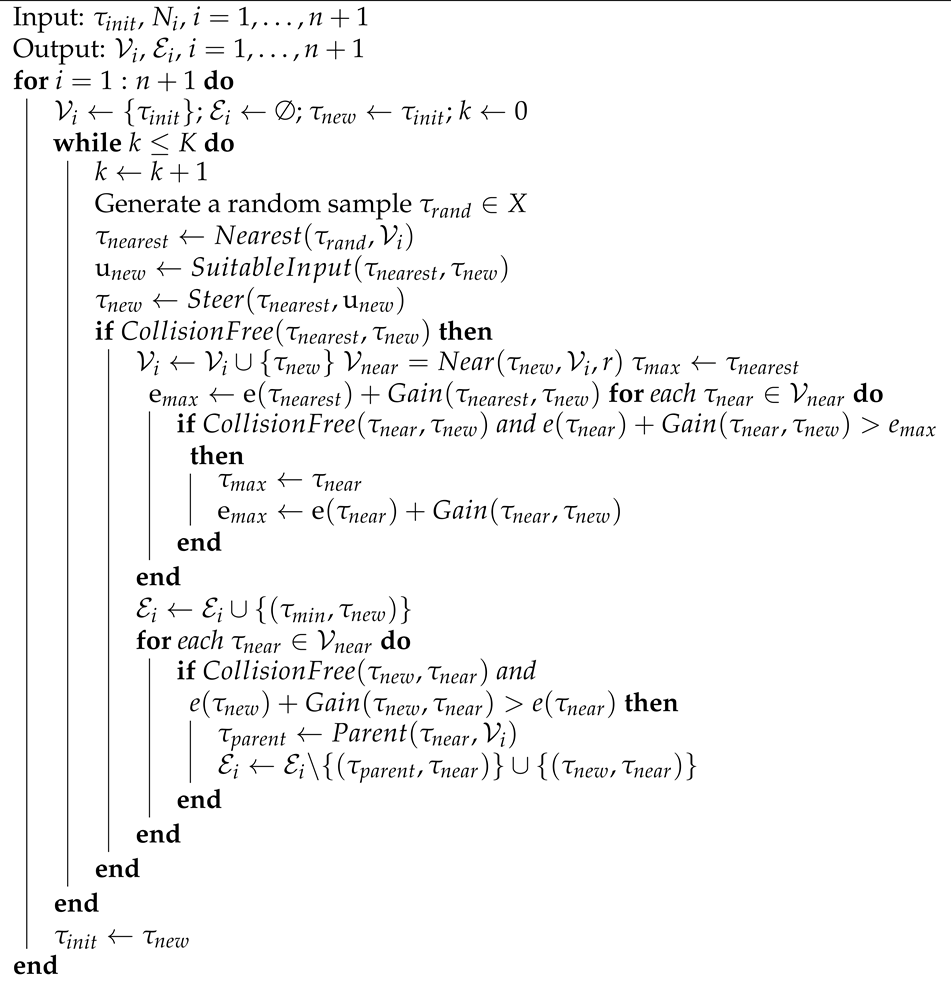 |
4.3. Optimized Inspection Tour
- : the sub-tour that has been improved.
- : returns the first vertex of the tour .
- : returns the last vertex of .
- : returns the completing time of .
- : returns the number of vertices in .
- : returns true if these exists a suitable control input u so that the vertex can reach with u. It is easy to understand that, under the constraints of the control inputs, the UAV may not reach some states from the current one.
- : update the annotations of the vertices of .
- : returns the time the UAV needs from the vertex to the vertex . This function can also take several vertices, i.e., a path, as the input.
- : returns the path from root vertex to another vertex in the ith random tree, i.e., . Every vertex in a tree is reachable from the root, and this function returns a unique path between the vertices and .
- : returns true if all the vertices of the tour have positive residual energy, i.e., .
| Algorithm 3: Tour improvement. |
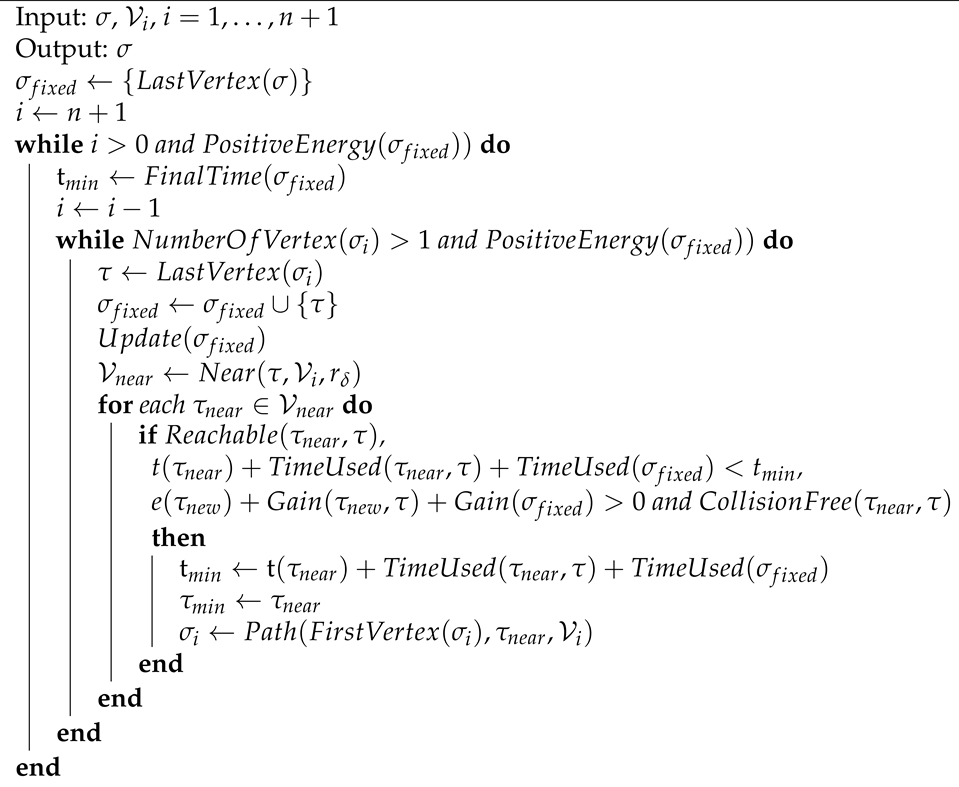 |
5. Simulation Results
6. Conclusions
Author Contributions
Funding
Institutional Review Board Statement
Informed Consent Statement
Conflicts of Interest
Abbreviations
| UAV | Unmanned aerial vehicles |
| RRT | Rapidly exploring random tree |
| TSP | Travelling salesman problem |
| TSPN | Travelling salesman problem with neighbourhood |
| LoS | Line-of-sight |
References
- Silvagni, M.; Tonoli, A.; Zenerino, E.; Chiaberge, M. Multipurpose UAV for search and rescue operations in mountain avalanche events. Geomat. Nat. Hazards Risk 2017, 8, 18–33. [Google Scholar] [CrossRef]
- Nakadai, K.; Kumon, M.; Okuno, H.G.; Hoshiba, K.; Wakabayashi, M.; Washizaki, K.; Ishiki, T.; Gabriel, D.; Bando, Y.; Morito, T.; et al. Development of microphone-array-embedded UAV for search and rescue task. In Proceedings of the 2017 IEEE/RSJ International Conference on Intelligent Robots and Systems (IROS, Vancouver, BC, Canada, 24–28 September 2017; pp. 5985–5990. [Google Scholar]
- Hayat, S.; Yanmaz, E.; Brown, T.X.; Bettstetter, C. Multi-objective UAV path planning for search and rescue. In Proceedings of the 2017 IEEE International Conference on Robotics and Automation (ICRA), Singapore, 29 May–3 June 2017; pp. 5569–5574. [Google Scholar]
- Huang, H.; Savkin, A.V. Energy-Efficient Autonomous Navigation of Solar-Powered UAVs for Surveillance of Mobile Ground Targets in Urban Environments. Energies 2020, 13, 5563. [Google Scholar] [CrossRef]
- Huang, H.; Savkin, A.V.; Ni, W. Energy-Efficient 3D Navigation of a Solar-Powered UAV for Secure Communication in the Presence of Eavesdroppers and No-Fly Zones. Energies 2020, 13, 1445. [Google Scholar] [CrossRef]
- Klesh, A.T.; Kabamba, P.T. Solar-powered aircraft: Energy-optimal path planning and perpetual endurance. J. Guid. Control. Dyn. 2009, 32, 1320–1329. [Google Scholar] [CrossRef]
- Lee, J.; Yu, K. Optimal Path Planning of Solar-Powered UAV Using Gravitational Potential Energy. IEEE Trans. Aerosp. Electron. Syst. 2017, 53, 1442–1451. [Google Scholar] [CrossRef]
- Bouzid, Y.; Bestaoui, Y.; Siguerdidjane, H. Guidance-Control System of a Quadrotor for Optimal Coverage in Cluttered Environment with a Limited Onboard Energy: Complete Software. J. Intell. Robot. Syst. 2019, 95, 707–730. [Google Scholar] [CrossRef]
- Hari, S.K.K.; Rathinam, S.; Darbha, S.; Kalyanam, K.; Manyam, S.G.; Casbeer, D. Efficient Computation of Optimal UAV Routes for Persistent Monitoring of Targets. In Proceedings of the 2019 International Conference on Unmanned Aircraft Systems (ICUAS), Atlanta, GA, USA, 11–14 June 2019; pp. 605–614. [Google Scholar] [CrossRef]
- Sachs, G.; Lenz, J.; Holzapfel, F. Unlimited Endurance Performance of Solar UAVs with Minimal or Zero Electrical Energy Storage. In Proceedings of the AIAA Guidance, Navigation, and Control Conference, Chicago, IL, USA, 10–13 August 2009; p. 6013. [Google Scholar]
- Gao, X.Z.; Hou, Z.X.; Guo, Z.; Chen, X.Q.; Chen, X.Q. Joint optimization of battery mass and flight trajectory for high-altitude solar-powered aircraft. Proc. Inst. Mech. Eng. Part G J. Aerosp. Eng. 2014, 228, 2439–2451. [Google Scholar] [CrossRef]
- Dai, R.; Lee, U.; Hosseini, S.; Mesbahi, M. Optimal path planning for solar-powered UAVs based on unit quaternions. In Proceedings of the 2012 IEEE 51st IEEE Conference on Decision and Control (CDC), Maui, HI, USA, 10–13 December 2012; pp. 3104–3109. [Google Scholar]
- Hosseini, S.; Dai, R.; Mesbahi, M. Optimal path planning and power allocation for a long endurance solar-powered UAV. In Proceedings of the 2013 American Control Conference, Washington, DC, USA, 17–19 June 2013; pp. 2588–2593. [Google Scholar]
- Spangelo, S.; Gilbert, E.; Klesh, A.; Kabamba, P.; Girard, A. Periodic energy-optimal path planning for solar-powered aircraft. In Proceedings of the AIAA Guidance, Navigation, and Control Conference, Chicago, IL, USA, 10–13 August 2009; p. 6016. [Google Scholar]
- Wei, X.; Yao, P.; Xie, Z. Comprehensive Optimization of Energy Storage and Standoff Tracking for Solar-Powered UAV. IEEE Syst. J. 2020, 1–11. [Google Scholar] [CrossRef]
- Wu, J.; Wang, H.; Li, N.; Yao, P.; Huang, Y.; Su, Z.; Yu, Y. Distributed trajectory optimization for multiple solar-powered UAVs target tracking in urban environment by Adaptive Grasshopper Optimization Algorithm. Aerosp. Sci. Technol. 2017, 70, 497–510. [Google Scholar] [CrossRef]
- Padilla, G.E.G.; Kim, K.J.; Park, S.H.; Yu, K.H. Flight Path Planning of Solar-Powered UAV for Sustainable Communication Relay. IEEE Robot. Autom. Lett. 2020, 5, 6772–6779. [Google Scholar] [CrossRef]
- Fu, Q.; Liang, X.; Zhang, J.; Qi, D.; Zhang, X. A Geofence Algorithm for Autonomous Flight Unmanned Aircraft System. In Proceedings of the 2019 International Conference on Communications, Information System and Computer Engineering (CISCE), Haikou, China, 5–7 July 2019; pp. 65–69. [Google Scholar] [CrossRef]
- Hosseinzadeh, M. UAV geofencing: Navigation of UVAs in constrained environments. In Unmanned Aerial Systems; Elsevier: Amsterdam, The Netherlands, 2021; pp. 567–594. [Google Scholar]
- Booth, K.E.C.; Piacentini, C.; Bernardini, S.; Beck, J.C. Target Search on Road Networks With Range-Constrained UAVs and Ground-Based Mobile Recharging Vehicles. IEEE Robot. Autom. Lett. 2020, 5, 6702–6709. [Google Scholar] [CrossRef]
- Huang, H.; Savkin, A.V.; Huang, C. A new parcel delivery system with drones and a public train. J. Intell. Robot. Syst. 2020, 100, 1341–1354. [Google Scholar] [CrossRef]
- Matveev, A.S.; Savkin, A.V.; Hoy, M.; Wang, C. Safe Robot Navigation among Moving and Steady Obstacles; Elsevier: London, UK, 2015. [Google Scholar]
- Sun, Y.; Xu, D.; Ng, D.W.K.; Dai, L.; Schober, R. Optimal 3D-trajectory design and resource allocation for solar-powered UAV communication systems. IEEE Trans. Commun. 2019, 67, 4281–4298. [Google Scholar] [CrossRef]
- Savkin, A.V.; Huang, H.; Ni, W. Securing UAV Communication in the Presence of Stationary or Mobile Eavesdroppers via Online 3D Trajectory Planning. IEEE Wirel. Commun. Lett. 2020, 9, 1211–1215. [Google Scholar] [CrossRef]
- LaValle, S.M. Planning Algorithms; Cambridge University Press: Cambridge, UK, 2006. [Google Scholar]
- Karaman, S.; Frazzoli, E. Sampling-based algorithms for optimal motion planning. Int. J. Robot. Res. 2011, 30, 846–894. [Google Scholar] [CrossRef]
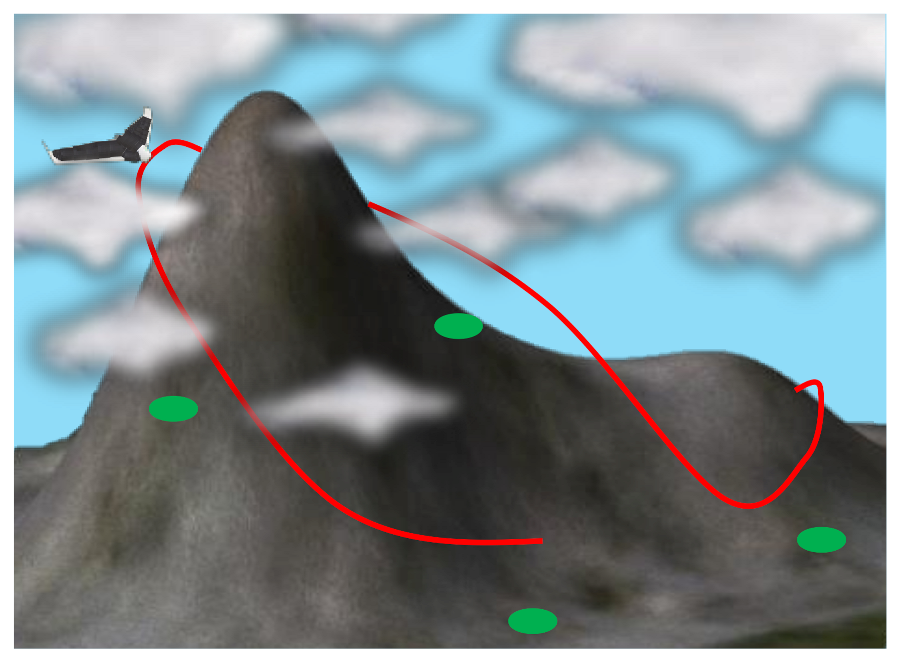


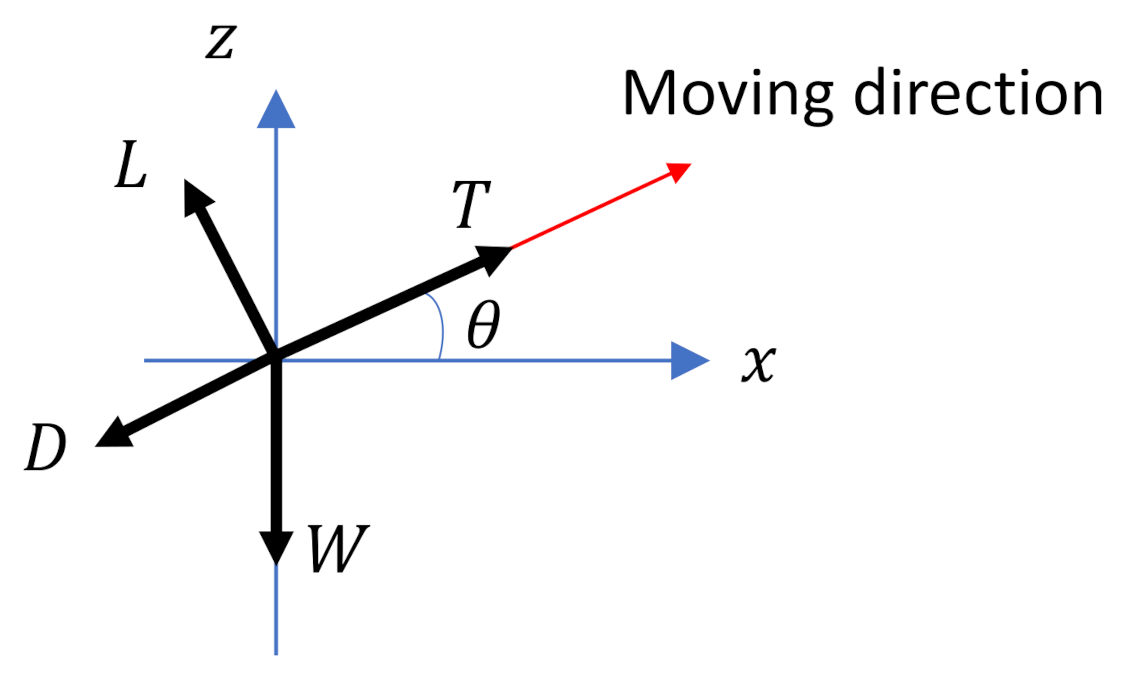

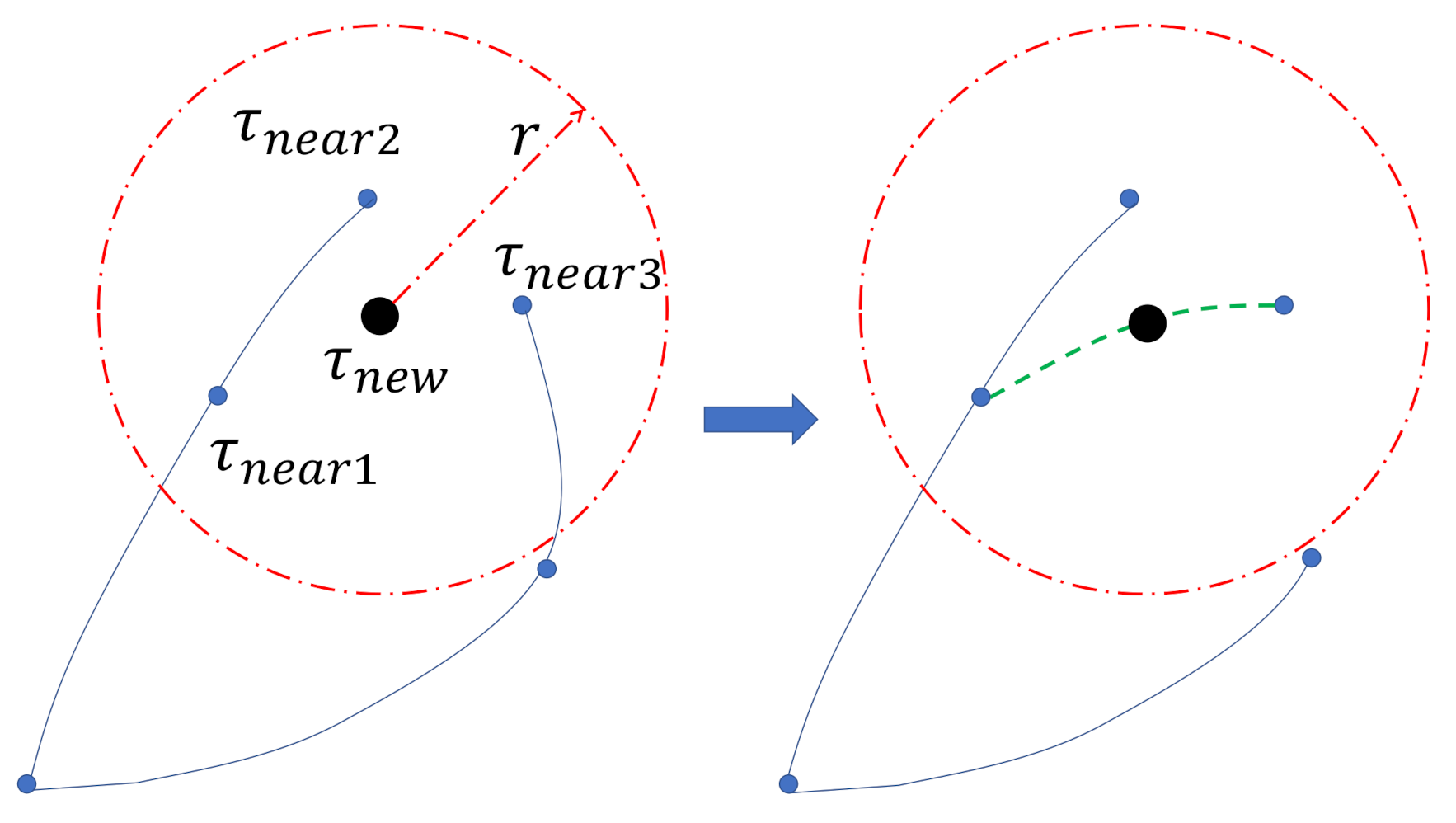


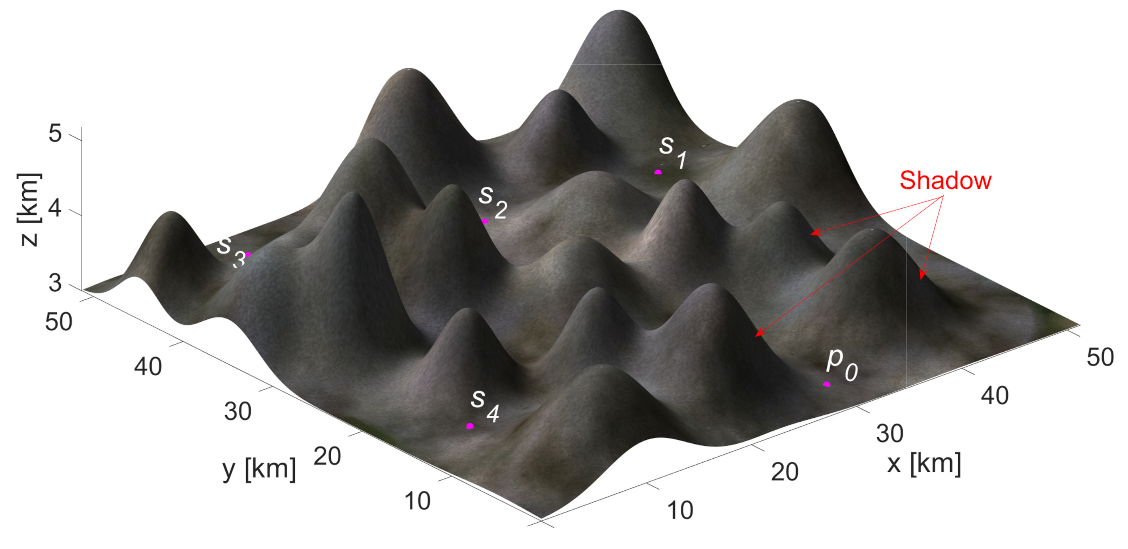
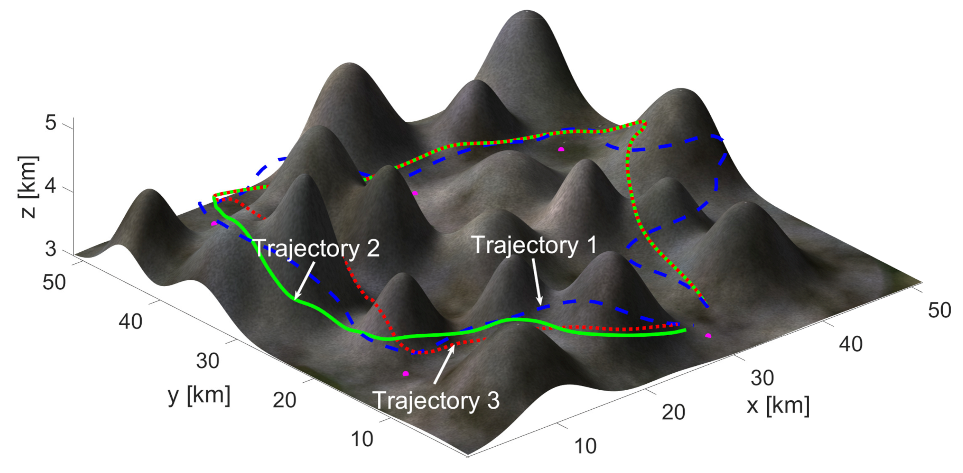
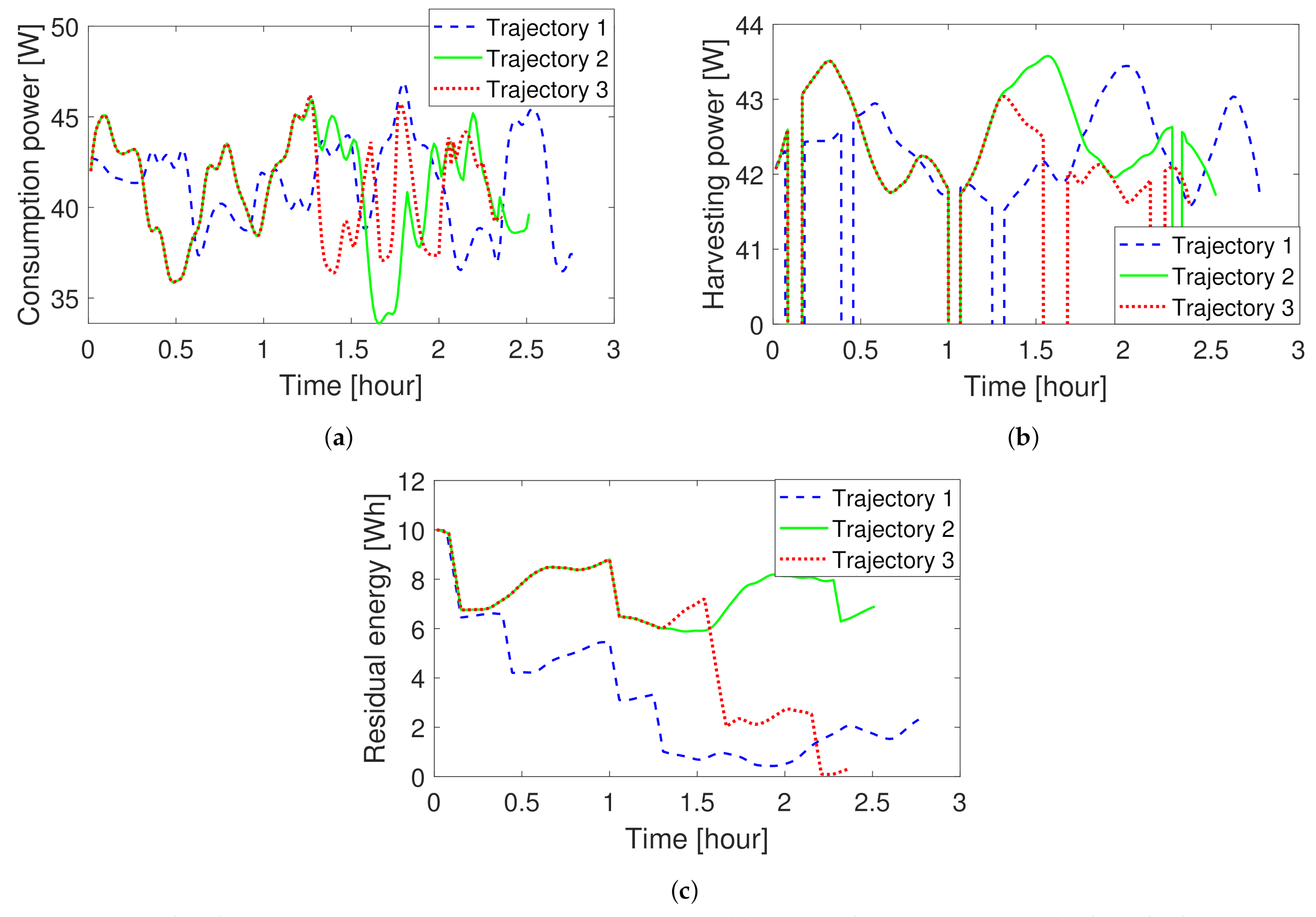
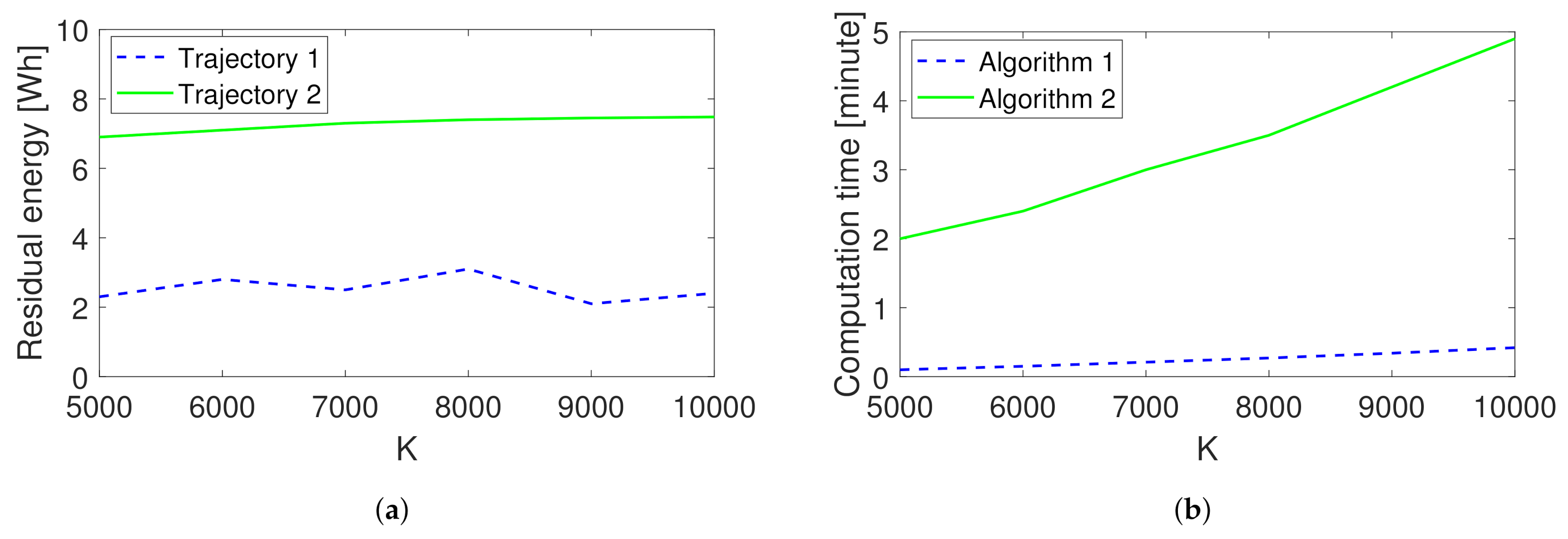
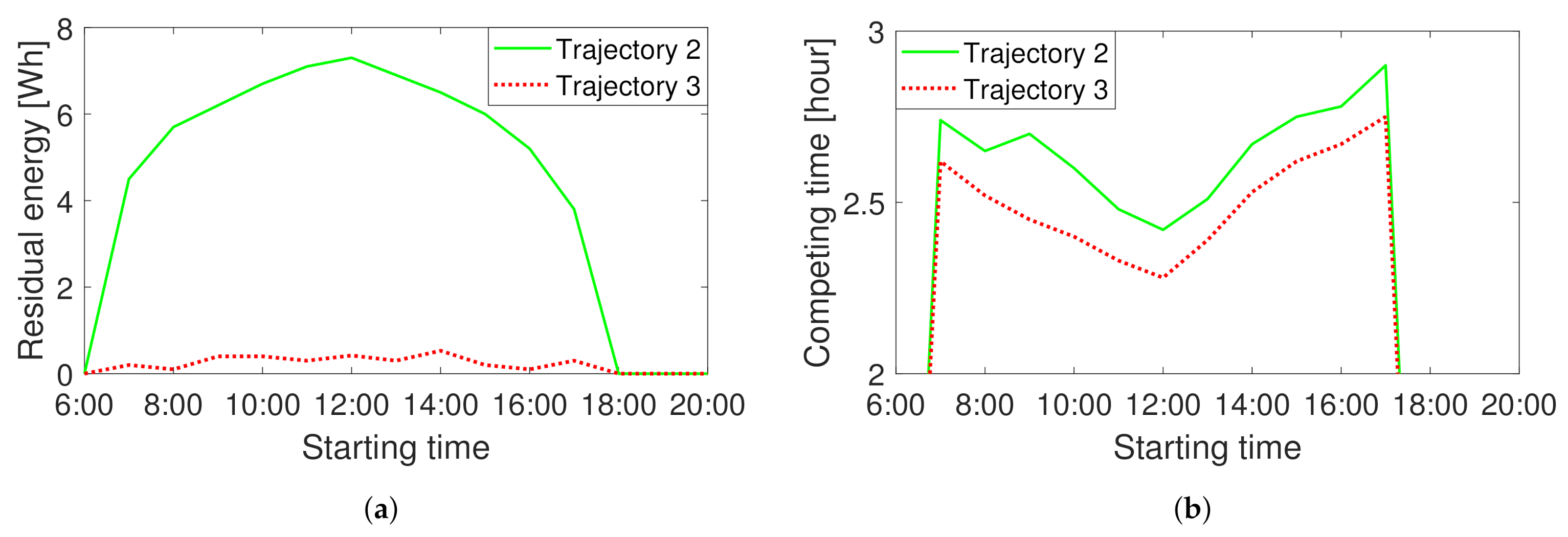
| Symbol | Meaning | Symbol | Meaning |
|---|---|---|---|
| UAV position | V | UAV speed | |
| Flight path angle | Heading angle | ||
| Flight path angle rate | Bank angle | ||
| Thrust force | Drag force | ||
| S | Mountain surface | Sunlight vector | |
| Incidence angle | UAV residual energy | ||
| Harvesting power | Consuming power | ||
| Site i | Neighbourhood of site i | ||
| LoS indicator | Inspection tour |
| Symbol | Value | Symbol | Value |
|---|---|---|---|
| 0.65 | 0.17 | ||
| 0.787 | 0.525 | ||
| W | 25 N | 3.9 W | |
| V | 15 m/s | 20 Wh | |
| 0.011 | 3.2 | ||
| 0.8 | 100 m | ||
| 2 min | G | 1.367 kW | |
| 3.5 km | 8 km | ||
| 0.01 | 1.29 kg | ||
| 2 | 2 |
| Trajectory | 1 | 2 | 3 |
|---|---|---|---|
| Completing time | 2.80 h | 2.55 h | 2.39 h |
| Residual energy | 2.3 Wh | 6.9 Wh | 0.3 Wh |
| Energy consumption | 115.0 Wh | 103.8 Wh | 97.4 Wh |
| Energy harvesting | 107.3 Wh | 100.7 Wh | 87.6 Wh |
| In-shadow ratio | 9.0% | 6.6% | 12.9% |
Publisher’s Note: MDPI stays neutral with regard to jurisdictional claims in published maps and institutional affiliations. |
© 2021 by the authors. Licensee MDPI, Basel, Switzerland. This article is an open access article distributed under the terms and conditions of the Creative Commons Attribution (CC BY) license (https://creativecommons.org/licenses/by/4.0/).
Share and Cite
Huang, H.; Savkin, A.V. Path Planning for a Solar-Powered UAV Inspecting Mountain Sites for Safety and Rescue. Energies 2021, 14, 1968. https://doi.org/10.3390/en14071968
Huang H, Savkin AV. Path Planning for a Solar-Powered UAV Inspecting Mountain Sites for Safety and Rescue. Energies. 2021; 14(7):1968. https://doi.org/10.3390/en14071968
Chicago/Turabian StyleHuang, Hailong, and Andrey V. Savkin. 2021. "Path Planning for a Solar-Powered UAV Inspecting Mountain Sites for Safety and Rescue" Energies 14, no. 7: 1968. https://doi.org/10.3390/en14071968
APA StyleHuang, H., & Savkin, A. V. (2021). Path Planning for a Solar-Powered UAV Inspecting Mountain Sites for Safety and Rescue. Energies, 14(7), 1968. https://doi.org/10.3390/en14071968







